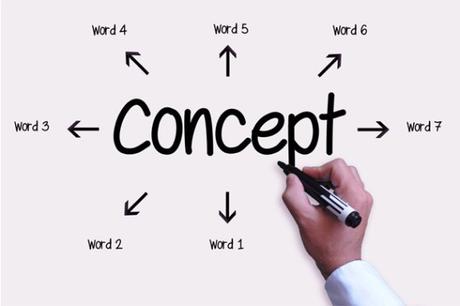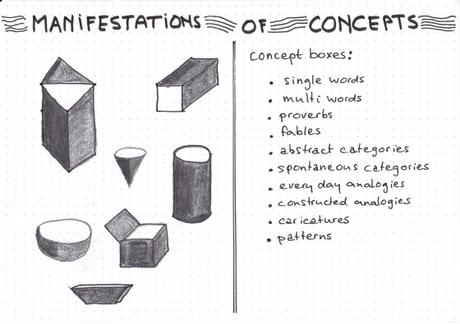How to recognize concepts?
A concept can be described as a perceived pattern or regularity in events or objects. We form groups of different events or objects into a single category on the basis of some underlying similarity. We are often not aware of what aspects or characteristcs that are underlying the categorization of events and objects into concepts. In a sense, when becoming manifested, the embodiment of an concept will become clear.  Concepts or categories can be associated with a single word. The development of “single word” concepts in young children is fascinating, as Douglas Hofstadter and Emmanuel Sander show in their book Surfaces and Essences.A child forms their first concepts between birth and three years of age. The construction of concepts begins before the acquisition of language. Hofstadter and Sander discusses how categories associated with a single word are constantly having their boundaries extended by analogies, the word mom is extended when the child acquires words like grandma, fairy-queen, and surrogate mother. Other single word concepts are words such as town, village, room, seat, table, store, but also more abstract words like society, liberalism, economics, law, money In addition, there are multi word concepts, like Achilles heel, that seems to indicate a whole complex of meaning that could be used to describe a situation in only two words (“A serious weakness that may lead to someone’s undoing”). Many proverbs and fables are multi word concepts, like we earlier discussed in Sayings and Proverbs as Thinking Patterns. Examples are A picture paints a thousand words or Penny wise, Pound foolish. There also much more abstract concepts and spontaneous categories, that somehow make a reference to a situation experienced before or to an analogous situation. Examples are “she hit me with her question” or “it’s no different than moving the deck chairs on the Titanic”. New categories are constructed every day to give concise meaning to situations or phenomena. Sometimes they have the form of a caricature such as uncle Dagobert stands for greed, a Kafkaeske situation for bureaucratic loopholes.
Concepts or categories can be associated with a single word. The development of “single word” concepts in young children is fascinating, as Douglas Hofstadter and Emmanuel Sander show in their book Surfaces and Essences.A child forms their first concepts between birth and three years of age. The construction of concepts begins before the acquisition of language. Hofstadter and Sander discusses how categories associated with a single word are constantly having their boundaries extended by analogies, the word mom is extended when the child acquires words like grandma, fairy-queen, and surrogate mother. Other single word concepts are words such as town, village, room, seat, table, store, but also more abstract words like society, liberalism, economics, law, money In addition, there are multi word concepts, like Achilles heel, that seems to indicate a whole complex of meaning that could be used to describe a situation in only two words (“A serious weakness that may lead to someone’s undoing”). Many proverbs and fables are multi word concepts, like we earlier discussed in Sayings and Proverbs as Thinking Patterns. Examples are A picture paints a thousand words or Penny wise, Pound foolish. There also much more abstract concepts and spontaneous categories, that somehow make a reference to a situation experienced before or to an analogous situation. Examples are “she hit me with her question” or “it’s no different than moving the deck chairs on the Titanic”. New categories are constructed every day to give concise meaning to situations or phenomena. Sometimes they have the form of a caricature such as uncle Dagobert stands for greed, a Kafkaeske situation for bureaucratic loopholes.  As you may have noticed, in this blog we write a lot about thinking patterns. That is: patterns of concepts that are used in thinking. One of the ways to discover thinking patterns is to pay attention to the words that are used, especially if some words come back regularly. When we pay attention, it becomes possible to identify the “thinking pattern behind a policy paper”, that is, the basic concept of the policy. We mentioned earlier that language is not innocent, and that concepts function like filters of reality, at the same time they will give meaning of reality. If we are able to concisely describe the basic thinking of a policy maker, then we make it vulnerable for constructive criticism. That will be one of our next posts about concepts. To read more about Thinking Patterns in science: click here
As you may have noticed, in this blog we write a lot about thinking patterns. That is: patterns of concepts that are used in thinking. One of the ways to discover thinking patterns is to pay attention to the words that are used, especially if some words come back regularly. When we pay attention, it becomes possible to identify the “thinking pattern behind a policy paper”, that is, the basic concept of the policy. We mentioned earlier that language is not innocent, and that concepts function like filters of reality, at the same time they will give meaning of reality. If we are able to concisely describe the basic thinking of a policy maker, then we make it vulnerable for constructive criticism. That will be one of our next posts about concepts. To read more about Thinking Patterns in science: click here
